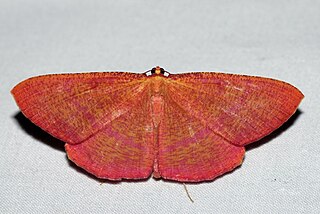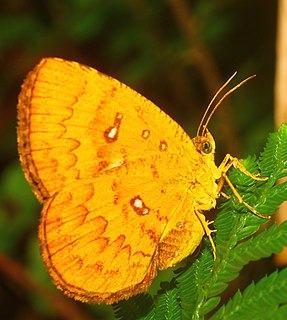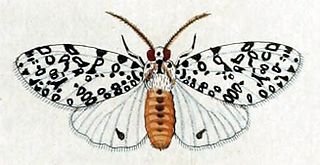
Eleuthera refers both to a single island in the archipelagic state of The Commonwealth of the Bahamas and to its associated group of smaller islands. Eleuthera forms a part of the Great Bahama Bank. The island of Eleuthera incorporates the smaller Harbour Island. "Eleuthera" derives from the feminine form of the Greek adjective ἐλεύθερος (eleútheros), meaning "free". Known in the 17th century as Cigateo, it lies 80 km east of Nassau. It is long and thin—180 km long and in places little more than 1.6 km wide. Its eastern side faces the Atlantic Ocean, and its western side faces the Great Bahama Bank. The topography of the island varies from wide rolling pink sand beaches to large outcrops of ancient coral reefs, and its population is approximately 11,000. The principal economy of the island is tourism.
Baritius is a genus of moths in the family Erebidae. The genus was erected by Francis Walker in 1855.

Tellervini is a tribe of danaid butterflies with only the one genus Tellervo, with six widely distributed species found in the Australasian realm and the Indomalayan realm. The taxon is apparently monophyletic, but its relationship with the other two danaid tribes is yet uncertain. The phylogeography of the group is also a challenge to those who hold to a Cenozoic origin of the butterflies.

Phostria is a genus of moths of the family Crambidae.

Eumelea rosalia is a species of moth of the family Geometridae described by Caspar Stoll in 1781. It is found from the Indo-Australian tropics of India, Sri Lanka, Myanmar, east to northern Australia and New Caledonia.

Callidula is a genus of moths of the family Callidulidae.

Acosmeryx anceus is a moth of the family Sphingidae. It was described by Caspar Stoll in 1781, and it is known from India, New Guinea, and Queensland, Australia.

Eloria diaphana is a moth of the subfamily Lymantriinae first described by Stoll in 1781. It is found in Suriname.

Alpenus maculosus is a species of moth of the family Erebidae. It was described by Caspar Stoll in 1781. It is found along the Gold Coast and in Lagos, Sierra Leone, Guinea, Angola, Cameroon, Nigeria, the Republic of the Congo, Uganda, eastern Africa and Zimbabwe.
Euagra coelestina is a moth of the subfamily Arctiinae. It was described by Caspar Stoll in 1781. It is found in Suriname and the Brazilian state of Pará.

Syngamia florella, the orange-spotted flower moth or red waisted florella moth, is a moth of the family Crambidae. It was described by Caspar Stoll in 1781. It is found from South Carolina to Florida and from Arkansas to Texas, south to the West Indies and through Mexico to Argentina. It is also found on Bermuda.

Hypercompe cunigunda is a moth of the family Erebidae first described by Caspar Stoll in 1781. It is found in French Guiana, Suriname, Brazil, Venezuela, Ecuador and Bolivia.
Poliopastea eacus is a moth of the subfamily Arctiinae. It was described by Caspar Stoll in 1781. It is found in Suriname and Pará, Brazil.
Nyctemera evergista is a moth of the family Erebidae first described by Stoll in 1781. It is found on the Moluccas, Seram, Buru and in New Guinea.
Ordishia rutilus is a moth of the family Erebidae first described by Stoll in 1781. It is found in Costa Rica, Panama and Suriname.

Parathyris cedonulli is a moth of the family Erebidae first described by Caspar Stoll in 1781. It is found in French Guiana, Suriname, Brazil, Venezuela, Ecuador, Bolivia, Honduras and Belize.
Pseudocharis melanthus is a moth in the subfamily Arctiinae. It was described by Stoll in 1781. It is found in Colombia and Suriname.
Lypotigris reginalis is a moth in the family Crambidae. It was described by Caspar Stoll in 1781. It is found in Suriname, Trinidad and Tobago, Central America, the West Indies and Florida.

Elymnias vitellia is a butterfly in the family Nymphalidae. It was described by Caspar Stoll in 1781. It is found in the Indomalayan realm.
Flaccilla is a monotypic skipper butterfly genus in the family Hesperiidae described by Frederick DuCane Godman in 1901. It has one species, Flaccilla aecas, the aecas ruby-eye, described by Caspar Stoll in 1781. It is found from Mexico to southern Brazil.











